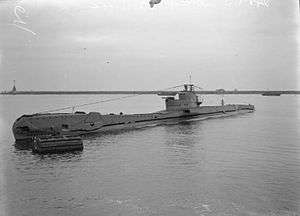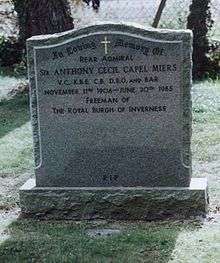Anthony Miers
| Sir Anthony Miers | |
|---|---|
 Anthony Miers | |
| Nickname(s) | Crap Miers |
| Born |
11 November 1906 Inverness, Scotland |
| Died |
30 June 1985 (aged 78) Inverness |
| Buried at | Tomnahurich Cemetery, Inverness |
| Allegiance |
|
| Service/branch |
|
| Years of service | 1929–1956 |
| Rank | Rear Admiral |
| Commands held | HMS Torbay |
| Battles/wars | Second World War |
| Awards |
Victoria Cross Knight Commander of the Order of the British Empire Companion of the Order of the Bath Distinguished Service Order & Bar Legion of Merit (United States) |
Rear Admiral Sir Anthony Cecil Capel Miers, VC, KBE, CB, DSO & Bar (11 November 1906 – 30 June 1985) (known as "Crap Miers" and "Gamp"[1]) was a Royal Navy officer, who served in the submarine service during the Second World War.
He was a Scottish recipient of the Victoria Cross, the highest and most prestigious award for gallantry in the face of the enemy that can be awarded to British and Commonwealth forces. He was deeply involved in two incidents alleged to be war crimes while commanding HMS Torbay.
Early life
Born in 1906, the son of an Army Captain killed in First World War, Miers was educated at Wellington College, before joining the Navy as a special entry cadet. He volunteered for the submarine service in 1929.
Service history

In November 1940 he was given command of HM Submarine Torbay. While working up, Torbay collided with the British tanker Vancouver in Loch Long though no serious damage was caused.
Torbay began its first patrol in March 1941. The submarine left at very short notice, with half the crew on leave and replaced by members of the spare crew of the depot ship, the reason being that the German battleships Scharnhorst and Gneisenau, had arrived at Brest and needed to be shadowed in case they sailed for the Atlantic sea lanes. The submarine later continued to Gibraltar, then Alexandria to join the 1st Submarine Flotilla.
On 27 April 1941, while on patrol off Cape Ferrato, Miers attacked a two-masted single-funnelled merchant ship of about 4000 GRT. Torbay fired two torpedoes but both missed.
Torbay's third war patrol was in the northern Aegean Sea. On 28 May 1941, Torbay sank two Greek caiques with gunfire, then torpedoed and damaged the Vichy French tanker Alberta off Cape Hellas.
In 1989 former Royal Naval Officer and broadcaster Ludovic Kennedy published his autobiography, in which he devoted several pages to "a submarine atrocity" on the night of 9 July 1941 which gave rise to the accusation of 'war crimes'.[2] According to the accounts, on two separate occasions, Miers ordered the machine-gunning of several shipwrecked German soldiers in rafts who had jumped overboard when their vessels were sunk by the Torbay. These events were witnessed and reported by acting First Lieutenant Paul Chapman who reported "everything and everybody was destroyed by one sort of gunfire or another".[3] Miers also made no attempt to conceal his actions, his patrol log recording: "Submarine cast off, and with the Lewis gun accounted for the soldiers in the rubber raft to prevent them from regaining their ship..." When informed of Miers's actions, Flag Officer Submarines, Admiral Horton wrote to the Admiralty about the possibility of German reprisals: "As far as I am aware, the enemy has not made a habit of firing on personnel in the water or on rafts even when such personnel were members of the fighting services; since the incidents referred to in Torbay's report, he may feel justified in doing so." The Admiralty then sent a strongly worded letter to Miers advising him not to repeat the practices of his last patrol.
According to historian Alfred de Zayas, the massacre was one of many incidents of the Royal Navy sinking Greek ships believed to be transporting German soldiers and then firing on the survivors in the water or in lifeboats. All were investigated by the Wehrmacht War Crimes Bureau, which collected depositions from all surviving German and Greek witnesses, which confirm Ludovic Kennedy's account of the massacre.[4]

He had already carried out nine successful patrols in HMS Torbay in the Mediterranean theatre before the patrol in March 1942 which saw the incident which earned him the VC. Whilst on patrol in HM Submarine Torbay off the Greek coast on the 4th March 1942 Lieutenant Commander Miers sighted a northbound convoy of four troopships entering the South Corfu Channel and since they had been too far distant for him to attack initially, he decided to follow in the hope of catching them in Corfu Harbour. During the night 4/5 March, Torbay approached undetected up the channel and remained on the surface charging her battery. The convoy passed straight through the channel but on the morning of the 5th March, in glassy sea conditions, Miers successfully attacked two store ships present in the roadstead and then brought Torbay safely back to the open sea. The submarine endured 40 depth charges and had been in closely patrolled enemy waters for seventeen hours.[5]
The citation in the London Gazette read:
Lieutenant Commander Anthony Cecil Chapel Miers DSO Royal NavyFor valour in command of H.M. Submarine Torbay in a daring and successful raid on shipping in a defended enemy harbour, planned with full knowledge of the great hazards to be expected during seventeen hours in waters closely patrolled by the enemy. On arriving in the harbour he had to charge his batteries lying on the surface in full moonlight, under the guns of the enemy. As he could not see his target he waited several hours and attacked in full daylight in a glassy calm. When he had fired his torpedoes he was heavily 'counter-attacked and had to withdraw through a long channel with anti-submarine craft all round and continuous air patrols overhead.[6]
His VC is on display in the Lord Ashcroft Gallery at the Imperial War Museum, London.
Later life

Miers continued to serve in the Royal Navy after the war, and achieved the rank of Rear Admiral in 1956.
Miers died in 1985. He is buried at Tomnahurich Cemetery, Inverness,[7] Scotland, in the Roman Catholic Section.
See also
Notes
- ↑ Izzard, Brian (2009). Gamp VC: The Wartime story of Maverick Submarine Commander Anthony Miers. Haynes Publishing. ISBN 978-1-84425-725-6.
- ↑ Forsyth, Frederick (18 December 2009), "WAR HERO OR WAR CRIMINAL?", Express Yourself, Express.co.uk
- ↑ Padfield:"War Beneath the Sea"
- ↑ Alfred M. de Zayas (1989}, The Wehrmacht War Crimes Bureau, 1939-1945, University of Nebraska Press. Pages 254-157.
- ↑ "Lieutenant Commander Anthony Cecil Chapel Miers". RN Subs. The Submariners Association (Barrow-in-Furness). 1997. Retrieved 13 May 2016.
- ↑ The London Gazette: (Supplement) no. 35622. p. 2983. 3 July 1942. Retrieved 23 June 2015.
- ↑ "Grave Location for Holders of the Victoria Cross in: Scotland". The Victoria Cross. Iain Stewart.
References
- Antoni Chmielowski
- Cooke, Graeme (1976). Silent Marauders: British Submarines in Two World Wars. Hart-Davis, MacGibbon. ISBN 0-246-10784-7.
- Harvey, David (1999). Monuments to Courage: Victoria Cross Monuments and Headstones. Kevin & Kay Patience.
- Izzard, Brian (2009). Gamp VC: The Wartime story of Maverick Submarine Commander Anthony Miers. Haynes Publishing. ISBN 978-1-84425-725-6.
- Laffin, John (1997). British VCs of World War 2: A Study in Heroism. Sutton Publishing Ltd.
- The Register of the Victoria Cross. This England Books. 1997.
- Ross, Graham (1995). Scotland's Forgotten Valour. MacLean Press. ISBN 1-899272-00-3.